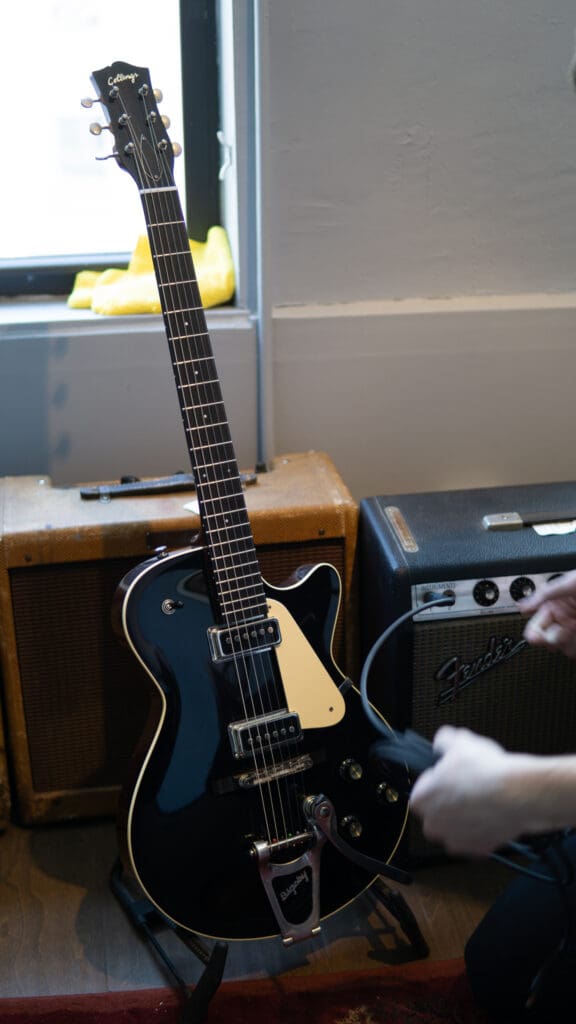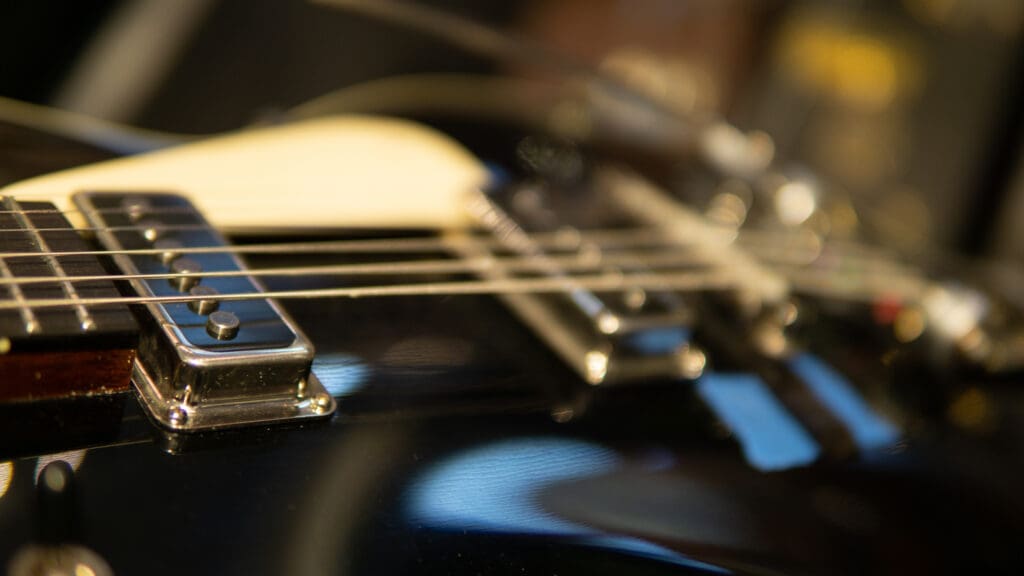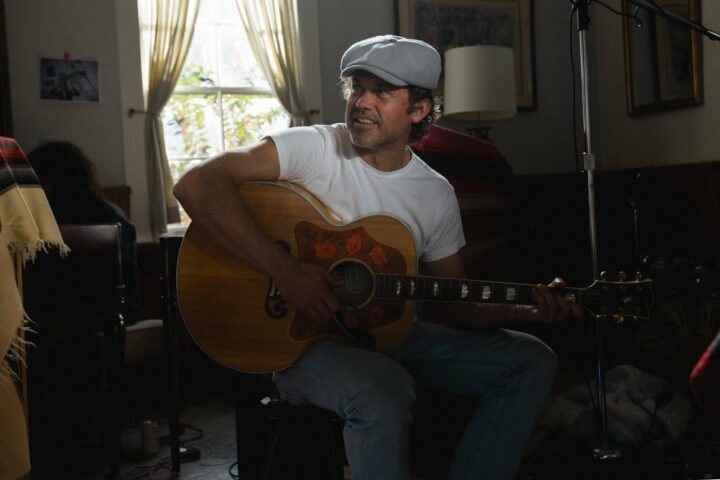Two seems like a lot of signature models for an artist from a shop that doesn’t really make signature models. The Pete Huttlinger Signature OM1 always had an air of special circumstances about it, and the OM1 JL, well, that doesn’t actually have Julian’s signature on it, anywhere. We’ve joked that it could be John Leventhal’s or Julie London’s (check out our interview with Julian on the OM1 JL’s development on this website). And yet the folks at Collings have unveiled another guitar with the JL designation, the 470 JL.
Julian first broached the idea of a new electric guitar with Mark Althans, Manager of Artist Relations and Customer Service at Collings, who brought the notion to Aaron Huff (Collings’ Director of Electric Guitars) and Clint Watson (Director of Engineering). As with the OM1 JL, the design and development process was intensive, and intensely collaborative. Although the very first prototype was essentially a modified version of the CL model, with a hollow body and a plywood top, they didn’t really start from a fixed point. They spent a lot of time observing how Julian plays, noting his posture, his attack, etc. Their notes about his left hand thumb position helped dictate the neck shape. Numerous, often subtle tweaks found their way into each successive iteration through the prototyping process, which was understandably extended by the pandemic — the 470 JL was initially announced at the 2020 NAMM show, but the guitar I briefly had my hands on a month later was subjected to quite a bit more refinement before the instrument’s official release, during NAMM’s 2021 virtual show.
And, of course, the spirit of Bill Collings loomed throughout.
As Aaron put it, “Some of what we’ve done in this back and forth has been quite funny, because as soon as we have a clearer picture we’ll move hard and fast to get closer to the target, in a very Bill Collings-like way, which is just, ‘Roll up your sleeves and make it happen. Make dust, right now.’ I know in my heart that Bill would be proud of this one.”

Fretboard Journal: How’d the new model come about?
Aaron: I’ll preface the story with this: Collings is an acoustic guitar company, and I don’t mean “round soundhole flattop.” I mean the way we pick wood, buy wood, think about wood, categorize wood, carve it, everything — whether it’s a solid body electric or a Waterloo mandolin, it all has the same philosophy behind it, to remain as aware as possible of the materials, such that you have the best musicality and quality for whatever it is that you’re playing.
I gave Julian an assignment, because when a guy like that comes to you, there’s a certain vagueness that makes it really difficult to put pencil to paper. So I said to Julian, “What kind of pickups are interesting to you right now?” Because when you start talking about pickups, you start to think about how does the characterization of some pickups filter the acoustic characteristics of the wood you might be working with. In other words, just by mentioning certain pickups you know whether you’ll be talking plywood hollow body, or ash solid body, or anything in between.
So when Julian decided what he was interested in, then we wound up on a quest for what that meant. He had spent some time with the old DynaSonic pickups in an older guitar, he’d done some recordings with it, he found things that he really enjoyed and he also found inherent limits that he didn’t enjoy. That’s where we come in and, in very Bill Collings-like fashion, begin to understand that organism and how we may have an influence on the musicality of building something that serves that purpose, but then add a lot of value in just understanding it.
That’s really how it got started, saying, “Okay, we want to talk together as a team to maybe come up with something special,” and I needed a starting place. That’s how we did it, which is a little bit different than how we’ve approached other ideas. We’re trying to clarify what “genre” we’re working in here, and it allowed us to have a take on, “What’s he after?” And when you watch him play, and then you watch how he operates a guitar, everything from his posture to his pick technique, you’re starting to realize what he relies on. So, pickup choice can be very revealing in how accurate you want to be to the acoustic sound.
Mark: If he was really intrigued with the sound of a DynaSonic, knowing how he sets the strings in motion, what his picking hand is like, you probably wouldn’t want to put that DynaSonic in a solid body guitar, because it would be too immediate and “ice-picky” of an attack. It really informed the build of the guitar. So it was an interesting assignment from that perspective.

FJ: The body’s chambered?
Aaron: Generally, when you think about a chambered guitar you think of a solid body with pockets of air in it, but this body, when it’s made, is completely open. Imagine just a big salad bowl. And then the trestle system is then glued into it, prior to the top being glued on. So, rather than a set of braces, it’s actually a singular structure down the center of the guitar that mates with the top all the way down the center, and also mates with the back, at the center of the back. Effectively what we’re doing there is allowing the airspace of the guitar to give you that open, throaty access that you expect from a hollow guitar, with the attack, or the note initiation of something with a center block. It’s derived from some of the other trestle-braced work we’ve been doing, but just pushed it to the next level in terms of higher mass in the center, which gives us a different attack for this particular model.
Mark: I think as a result it occupies this cool space between a center block guitar and a fully hollow guitar, in that you get increased nuance and dynamic response approaching that of a hollow body guitar but you also get some of the benefits of having more solidity in there. It’s a cool area that not a lot of builders explore.
Aaron: That’s really what we needed to do. I spent a lot of time watching Julian, with him playing some of the earlier prototypes, watching him playing acoustic guitars, the way he’s so cautious with his note initiation, you can see him desire a hollow body guitar, but you can see him require something with a little more attack. Seeing him play an acoustic guitar and seeing him play a Tele, you can see that he needs both … you can see him wanting to be in complete control of how the guitar responds — the guitar’s not making a decision for you, you can force it to be clear, you can allow it to be aloof, you can play it as an instrument and control its range. Having a more hollow guitar than what it’s inspired by gives us more range, acoustically, which you then have to counter with the structure that we developed.
Mark: What is kind of interesting is the solid mahogany back, the hollowed-out mahogany body definitely brings more acoustic properties and characteristics to the mix. Our original I-35, that was a solid-wood, carved instrument — a carved maple top, hollowed out mahogany shell and a [true] center block. That had a lot of the sound of the wood in there. For Aaron and Clint to build this guitar, that has that solid back, that’s really bringing a lot to the equation, but kind of neutralizing things in a controlled way with the laminate maple top. It’s just a really cool hybrid.

FJ: What about the top?
Aaron: We have a fairly thin maple plywood top, with alternating grain orientation in the layers, and it rings. I mean, it is not a dope. It is very acoustic. It’s selected for its ability to move and ring, but, as well, to be a little neutral, in the Julian preference.
FJ: The Bigsby tailpiece is something of a surprise…
Aaron: We tried it both ways. The Bigsby alters things a couple of ways: it adds a little bit of mass, and, having the spring that the tension of the strings is against, it has a very different attack. A lot of times with players like Julian, you don’t even see them hanging on to the bar, they just like the way that the note initiates off the guitar on a spring-loaded tailpiece.
The thing is, when you have, in this case, much lower mass, then you have a completely different inertia, and you have a different relationship with the string energy — when you have lower mass, the string energy has greater influence on the mass that you do have. All of a sudden the player has a lot of control.
Mark: The thing is just, basically, a race car. You have to know how to drive.
The Deets
The 470 JL sports a maple laminated top on a Honduran mahogany body. The neck is also Honduran mahogany, with an ebony fingerboard and headstock laminate, and its taper is unique among Collings electrics, with a taper that makes it slightly narrower at both the 1st and 12th fret than other models’. The nut is “slippery Delrin,” 1-11/16” wide, the scale length 24-7/8”. The bridge is a nylon saddled tune-o-matic with a pinned ebony base, the tailpiece a Bigsby B3 vibrato. The pickups are “Ellisonic” single coils by Ron Ellis, inspired by DeArmond Dynasonics but notably different upon close inspection, wired to a master volume and two tone controls (earlier prototypes sported a more unusual two volumes and a master tone configuration).

Editor’s Note: This story originally appeared in the Fretboard Journal #48.


